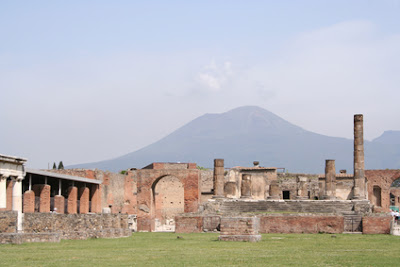The volcanic
eruption of Mount Vesuvius is the setting for my Christian romance, Romans (Early
Christians Book 1).
I based the
Christian meetings in the book on the records of the early Christians Justin
Martyr and Tertullian, as well as the later Clement, and Hippolytus
of Rome. These men recorded what happened in the Christian assemblies of the
time. Justin Martyr was born 21 years after this book's setting, but
his account is one of the earliest accounts (that is, after the writers of the
New Testament) of what happened when early Christians met.
The Apostle
Paul wrote The Book of Romans in 57 A.D. The eruption of Vesuvius
destroyed Pompeii Mount Vesuvius looming
over the ruins of Pompeii
Pompeii was a Roman city, and a popular tourist destination for wealthy Romans.
Here are some Pompeii streets.
The following photos show just how wealthy the houses were. This is obvious even from the ruins. You can see tourists' heads in the second photo, which gives you an idea of the ceiling height. (Attribution: By Wknight94 (Own work) [GFDL (http://www.gnu.org/copyleft/fdl.html) or CC-BY-SA-3.0 (http://creativecommons.org/licenses/by-sa/3.0/)], via Wikimedia Commons.)
The following photo is of a dining room wall. (Attribution: http://commons.wikimedia.org/wiki/File:Pompeji_Casa_Dei_Vettii_Hercules_Child.jpg#file)
Throughout Pompeii, the paintings were opulent.
Below is one of the many public drinking fountains in Pompeii. (Attribution: By Mentnafunangann (Own work) [CC-BY-SA-3.0 (http://creativecommons.org/licenses/by-sa/3.0)], via Wikimedia Commons)
The following photo is of another volcano erupting, but is a typical Plinian eruption. The Mount Vesuvius eruption of 79 AD. was a Plinian eruption.
A Plinian eruption does not have
lava, but features a giant towering column filled with magma, ash, and
super-heated gas which in Vesuvius' case, at its worst point reached over 20
miles into the air, at speeds greater over 400 miles an hour. 100,000 tons of
magma, super-heated gas, and ash were released from the volcano every second.
The magma cooled and fell back to
earth, along within the ash and lithics, which were rocks from inside the
volcano, and this fell on people at speeds of up to 100 miles per hour.
(Photo Attribution:
(Photo Attribution:











No comments:
Post a Comment
Note: only a member of this blog may post a comment.